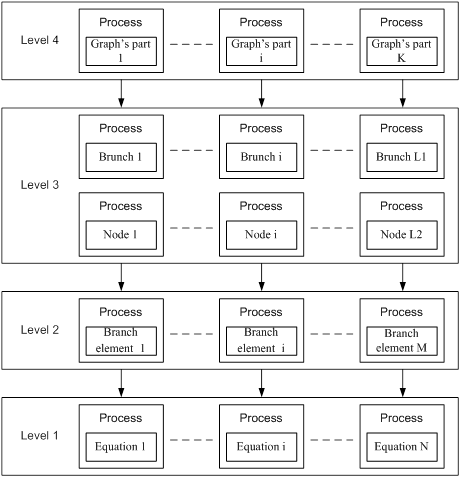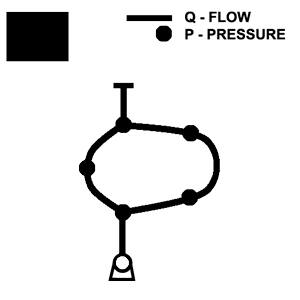Abstract
Contents
- Introduction
- 1. Theme urgency
- 2. Goal and tasks of the research
- 3. The concept of DPSE and the principle of decomposition into subsystems
- 4. Description of themed literature and researches
- Conclusion
- References
Introduction
In the modern world any hi-tech development requires an experimental research before the implementation. But full-scale experiments usually are difficult or economically unprofitable. The solution to this problem is simulation – the study of the properties of the objects with help of mathematical models of real objects.
With the development of computer technology computer simulation has become the most relevant area. But the ever-increasing complexity of objects leads to a corresponding increase of simulation time and of the power of computing resources. Single-thread systems cannot cope with the modern simulation tasks. So there is a need for the development and implementation of multi-thread simulation systems.
The introduction of new simulation concepts has led to the emergence of new problem – the need for a formal approach to the design and construction of complex problem-oriented parallel systems. So there was a concept of distributed parallel simulation environment (DPSE).
1. Theme urgency
DPSM works with the network dynamic object with distributed or concentrated parameters (NDODP and NDOCP). It is a formal description that contains a formalized topological representation of an object and a system of equations of physical processes of complex dynamical system (CDS).
Research and development of such system is an actual and perspective direction. And thanks to a principle of decomposition the development of each subsystem of DPSE is relatively independent task with a number of specific problems.
With the increasing complexity of the target systems for parallel simulation there is a problem of choosing the optimal structure of DPSE. Performing this operation during the development, implementation and devirtualization of the system can significantly reduce economic, time and resource costs. The prediction of the speedup during the parallelizing and further build of the system is also important, because it allows making a conclusion about its cost-effectiveness. Such problems are solved by system of a priori analysis.
2. Goal and tasks of the research
The goal of the work is research of methods and approaches to solving the problem of the a priori analysis of the virtual parallel models for controlled network dynamic object with distributed parameters.
Main tasks of the research:
- Development of mathematical description of the network object.
- Definition of the list of performance criteria for virtual parallel models.
- Mathematical description of performance criteria.
- Development of software support priori analysis.
- Development of recommendations for model devirtualization.
- Testing and simulation experiments.
3. The concept of DPSE and the principle of decomposition into subsystems
The concept of DPSE for CDS with distributed and concentrated parameters was proposed in 1992 within the framework of cooperation of Donetsk National Technical University and the Institute for Parallel and Distributed Systems (IPVS) University of Stuttgart (Germany). It was published in the report [1] and developed in [2].
According to [2] DPSE is user-friendly system organization of the hardware, system software and simulation software that supports all phases of development and implementation of NDODP and NDOCP. The main task is development of a fully functional DPSE with following parameters:
- Using of existing SIMD and MIMD-architectures in DPSE.
- Development of full-featured software for SIMD and MIMD-DPSE components simulation.
- Simulation of dynamic systems with concentrated and distributed parameters with a common methodological basis.
- Development of specialized software for parallel processes description.
- Object-oriented implementation of the simulation software.
- Availability of tools for work in all phases of the CDS development.
- A highly intelligent interactive user interface at all stages of development of CDS.
The development of such full-featured system is an extremely difficult task. To solve this problem there is a proposition in [2] of decomposition of the complex DPSE into several subsystems. Thus the development of each of these subsystems may be relatively independent from others.
According to this proposition DPSE should consist of the following subsystems:
- dialogue subsystem;
- topological analysis subsystem;
- equations generation subsystem;
- subsystem of virtual parallel models;
- subsystem of parallel equation solvers;
- data exchange subsystem;
- the load balancer subsystem;
- visualization subsystem;
- database subsystem;
- IT-support subsystem.
A priori analysis interacts directly with the subsystems of virtual parallel models, load balancer and data exchange subsystem and is closely associated with the process of virtual parallel model devirtualization.
Model devirtualization of a complex dynamic system is its transformation with methods and algorithms, providing optimal performance of the application on CDS in the target parallel computing system.
A priori estimation of the parallel virtual model during the devirtualization helps to determine the optimal approach to parallelization by considering its possible levels of parallelism and the variants that have better performance.
4. Description of themed literature and researches
The task of a priori analysis appeared with the appearance of parallel computing systems. There is a number of works, which are devoted to this problem, but there is no complete hardware and software solution.
The basic work by theme of a priori analysis of the virtual models is [3]. It discusses in detail the major theoretical issues on the basis of specific examples. There is a system’s concept and mathematical basis in this work.
Thus, according to [3], the main objectives of a priori analysis are:
- consideration of the possible approaches to parallelization and structural representation of NDODP;
- research and compare the levels of parallelism according to the criteria of load distribution, data sharing and synchronization between processes;
- proposition and check the possible alternatives for the levels of parallelization organization;
- general comparison of levels of parallelization and formulation of recommendations for the further implementation of the model to a target computer system.
The main indicators of a priori analysis are [3]:
- uniformity of load of virtual processes;
- arithmetic operations and data exchange operations ratio;
- acceleration of calculations because of increase in quantity of processes;
- distribution of processes on the real processors during the implementation of the model to a target computer system.
A priori analysis is performed for virtual parallel models of the four levels of parallelization [3, 4] (fig. 1).
The first level is the level of the minimum granularity of processes. Determined by the ratio of "one equation – one process".
At the second level each process is assigned to an element of the branches of the graph. This level is characterized by the ratio of "one element – one process".
The third level is the level of parallelism of the "one node – one process" and "one branch – one process" ratio.
The fourth level is the decomposition of the graph into subgraphs with the least amount of connections to each other. In this case the number of processes depends from the number of subgraphs of NDODP.


It should be noted that work on the a priori analysis of parallel models was carried out in the Donetsk National Technical University in the context of the separate subsystems of DPSE, but it did not pay special attention.
Thus, in work [5] it is said that the aprioristic analysis of virtual parallel model is an integral and important part of devirtualization and implementation process of a model.
In [6] was made a priori analysis of network dynamic object with distributed parameters on the second level of parallelization.
It should be noted that the problems of parallel simulation is actively engaged in the European universities ([7], [8], [9]).
Thus, a system SEGL is actively developing in the High Performance Computing Center Stuttgart. It is a modern workflow instrument to describe and execute multi-dimensional programs on distributed high-performance computing resources. [10]
Also as an example it is possible to allocate the work [11] which purpose is development a basis for the use of parallel and distributed simulation systems. The basic attention is given to modeling of complex manufacturing processes. The work contains a substantiation of efficiency of such systems in modern technological processes. The aim of this work is definition of the basic principles of achieving accelerated simulation through parallelization and distribution.
Conclusion
A priori analysis is an important task immediately preceding the implementation of the DPSE model devirtualization.
Master's work is devoted to an actual problem of the a priori analysis of the virtual parallel models for controlled network dynamic object with distributed parameters.
In this work the relevance of developments in this direction was defined. Main developments on this issue were analyzed. The main approaches, concepts and general mathematical apparatus of a priori analysis were examined.
Further work is aimed at:
- Expansion of the mathematical description of the network object for the approximation of the model's properties to the properties of a real network.
- Extension of the performance criteria of virtual parallel models and their mathematical description.
- Getting on the basis of work more specific recommendations for further model devirtualization.
This master's work is not completed yet. Final completion: December 2013. The full text of the work and materials on the topic can be obtained from the author or his head after this date.
References
- Anoprienko A.J., Svjatnyj V.A., Braunl T., Reuter A., Zeitz M.: Massiv parallele Simulationsumgebung fur dynamische Systeme mit konzentrierten und verteilten Parametern. // 9. Symposium ASIM’94, Tagungsband, Vieweg – 1994, S. 183-188.
- Feldmann L.P., Svjatnyj V.A., Resch M., Zeitz M.: Forschungsgebiet: parallele Simulationstechnik. // Наукові праці Донецького національного технічного університету. Серія: Проблеми моделювання і автоматизації проектування [Electronic resource]. – Access mode: http://www.nbuv.gov.ua/portal/natural/Npdntu/Pm/2008/08flpfps.pdf.
- Svjatnyj V.A.: Virtuelle parallele Simulationsmodelle und ein Devirtualisierungsvorgang der Entwicklung von parallelen Simulatoren fur dynamische Netzobjekte mit verteilten Parametern. Teil 4. // Vortrag am HLRS – 2008.
- Молдованова О.В. Проблемно орієнтоване паралельне моделююче середовище для мережних динамічних об’єктів з розподіленими параметрами: Дис. канд. наук // 01.05.02 – 2008.
- Святний В.А., Молдованова О.В., Чут А.М.: Стан та перспективи розробок паралельних моделюючих середовищ для складних динамічних систем з розподіленими та зосередженими параметрами // Наукові праці Донецького національного технічного університету. Серія: Інформатика, кібернетика та обчислювальні методи [Electronic resource]. – Access mode: http://www.nbuv.gov.ua/portal/natural/Npdntu/2008/ikot/08svasgt.pdf.
- Войтов А.В., Святний В.А.: Апріорний аналіз віртуальної паралельної моделі другого рівня мережного динамічного об'єкта з розподіленими параметрами. // Наукові праці Донецького національного технічного університету. Серія: Динамічні системи, моделювання та чисельні методи [Electronic resource]. – Access mode: http://ea.donntu.ru:8080/jspui/bitstream/123456789/14354/1/6_Войтов.pdf.
- Max-Planck-Institut fur Dynamik komplexer technischer Systeme. [Electronic resource]. – Access mode: http://www.mpi-magdeburg.mpg.de/.
- Institut fur Parallele und Verteilte Systeme Universitat Stuttgart. [Electronic resource]. – Access mode: http://www.ipvs.uni-stuttgart.de/index1.html.
- High Performance Computing Center Stuttgart. [Electronic resource]. – Access mode: http://www.hlrs.de/.
- Science Experimental Grid Laboratory. [Electronic resource]. – Access mode: http://segl.hlrs.de/.
- Schulz Roland: Parallele und Verteilte Simulation bei der Steuerung komplexer Produktionssysteme. Dissertation zur Erlangung des akademischen Grades eines Doktors der Wirtschaftswissenschaften. // Ilmenau – 2002.
- Svjatnyj V.A.: Virtuelle parallele Simulationsmodelle und ein Devirtualisierungsvorgang der Entwicklung von parallelen Simulatoren fur dynamische Netzobjekte mit verteilten Parametern. Teil 6: Systemorganisation und Subsysteme verteilter paralleler Simulationsumgebung. Parallele blockorientierte Simulationssprache: ein Entwicklungskonzept. // Vortrag am HLRS – 2010.
